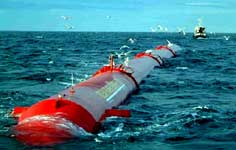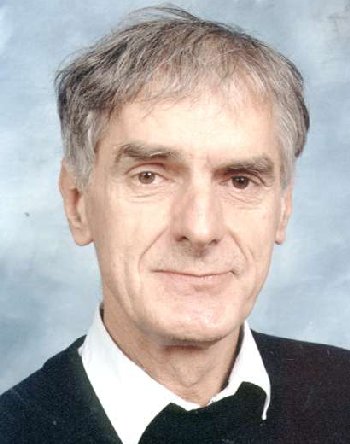What do you do when you’re the father of a whole industry? Do you sit back and relax, or carry on to pastures new? If you’re Prof Stephen Salter, widely acknowledged as the leading pioneer of marine energy, then you take the latter path.
Salter’s work on wave energy at Edinburgh University in the 1970s led to the development of the device known as Salter’s Duck, the first practical wave energy converter and the basis of the technology now used in machines such as the Pelamis ‘sea-snake’. Wave energy remains controversial — Salter still believes that development of the Duck was derailed by pressure from the nuclear industry — but not content with that, Salter is now deeply involved with an even more controversial sector. He’s convinced that geoengineering could be a valuable tool to mitigate some of the most pressing effects of climate change; and he believes that it could — and should — be implemented sooner rather than later.

Geoengineering is the use of technology to affect the climate deliberately, to induce a cooling effect globally or in a smaller region. It is a controversial subject, because of concerns that it distracts attention from reducing carbon emissions — which most climate scientists agree is the best method of reducing climate change — and that it could have unpredictable effects on the complex and poorly understood processes which control the climate. Proponents, including Salter, believe that geoengineering can buy us time to investigate and ameliorate climate change by mitigating its most serious effects.
Salter is an advocate of the high-albedo cloud method of cooling — generating reflective clouds that bounce the sun’s radiation back into space, preventing it from reaching the Earth’s surface. There are two methods available for doing this. One works by injecting an aerosol of sulphate — sulphur-dioxide gas is usually proposed — into the stratosphere to create a mist of dilute sulphuric acid droplets. The other, which is favoured by Salter, uses a mist of very fine droplets of water, which act as nucleation agents for the water vapour already in the atmosphere, generating clouds in the vicinity of the mist generator.
High-albedo clouds
Salter believes that the planet is now at a crucial tipping point, with his concern being triggered by recent news of record low levels of ice at the Arctic. ‘There really is quite a lot of urgency,’ he said. The Piomas (Pan-Arctic Ice Ocean Modeling and Assimilation System) programme, which is run by the University of Washington’s Applied Physics Laboratory and Polar Science centre, models ice thickness and volume, and has predicted a record low level this year. ‘Piomas is just a computer program but it’s checked by chaps getting out of submarines with tape measures, and those agree with the model,’ Salter said. ‘The model tends to overestimate thick and underestimate thin, so it’s probably worse than Piomas thinks.’
Another concern for Salter is data on the release of Arctic methane, which comes from permafrost regions; as they warm, methane trapped in the soil is released, and vegetation that had been frozen begins to rot as it thaws, generating more methane. This is a natural process, but climate change may accelerate it. And as methane is a far more powerful greenhouse gas than carbon dioxide (CO2), increasing releases of it may further accelerate global warming. A paper by researchers from the University of Alaska at Fairbanks published in May in the journal Nature Geoscience (read it here) identified some 150,000 sites in Alaska and Greenland where methane is seeping from the ground; examination of the isotopes of carbon from these sites showed that the methane was both ancient and modern in origin, possibly from lake-bed coal and gas deposits, and rotting vegetation respectively. A report from Russian scientists on similar sites in Siberia is expected towards the end of this year.
Salter believes that a cooling effect could be generated by producing high-albedo clouds in the polar region, and wants to target two particular areas. ‘There’s warm water flowing into the Arctic between Norway and Iceland, and similarly there’s a net flow through the Bering Strait of 8,000m3/sec,’ he said. ‘So what I’m looking at now is how we could release spray clouds from the Faroe Islands and the coast of Norway, and from the Aleutian Islands. Cooling those areas by just a tiny bit — 1°C would be enough — would reduce the heat going into the Arctic considerably.’
Salter prefers the water spray to the sulphate aerosol method because, he says, there are concerns over some side-effects of the latter. ‘There is now research showing that while it cools the world in general, it actually warms up the Arctic, in winter particularly,’ he said. ‘Because sulphates have a two-year lifespan in the atmosphere, you can’t be sure that what you put up on the Equator isn’t going to be around in a couple of years’ time during an Arctic winter, and by cooling the equator by a couple of watts, you could end up warming the Arctic by 10 watts.’
Previously, Salter has advocated placing spray units to generate clouds on purpose-built ships, with the sprays powered by underwater turbines (see our previous interview with him here). However, he believes that the cooling of the Arctic is so urgent that it would be better achieved using sprays powered by simple diesel engines. ‘It’s just the quickest way to get the spray up,’ he said.
Billions of nozzles
The spray devices themselves are of Salter’s own design, and are based on silicon wafers. A layer of silicon oxide is deposited onto one side of the wafer, then another layer of silicon on top of that. ‘You etch tiny nozzles, sub-micron sized, through the thin layer of silicon, stopping at the oxide layer, then you etch from the other side, through the thicker layer of silicon, again stopping at the oxide film. Then you etch away the oxide film. So you have maybe a thousand sub-micron nozzles meeting a much bigger nozzle, about 50 microns, going the other way. That means I can get two billion nozzles onto one 200mm-diameter wafer.’
The pumps push seawater, which has been filtered through a system designed to remove viruses from drinking water, against the large-nozzle side of the wafer, which is then pulsed with ultrasonics to force the water through the small nozzles. ‘It’s the number of droplets that matters [for nucleation],’ Salter said. ‘But they also need to be within a fairly narrow range of size, and that might vary. I’m designing the wafer for a single ultrasonic frequency, and we can change the size of the droplets by adjusting the flow rate, but keep the same number of droplets.’
This system has to be tested, and Salter is funding this himself. ‘I earn enough through consultancy on marine energy to be able to take a tiny bit of the spray generation system — a 4mm circle — that I can test in the lab,’ he said. With these results, and the increasing concern over ice thickness and volume, he believes that funding could become available. ‘I have no idea where I can get funding at the moment,’ he said, ‘but I think a lot will change over the next winter.’ Ever optimistic, Salter believes that the system would take as little as 18 months to build, install and start operating. ‘It should be possible with a big effort,’ he said.
From wave to wind to road, and back
One of the innovations Salter designed for the wave-generation Duck, a hydraulic transmission system, is now in trials for use with large wind turbines, and could have a future in fuel-efficient cars. A company set up to develop the transmission, Artemis Intelligent Power, was acquired by Mitsubishi Power Systems in 2010, and is now carrying out further development.
Artemis’s technology, which it calls Digital Displacement, uses computer-controlled solenoid valves to control the flow of high-pressure oil through cylinders arranged radially around a rotating eccentric (off-centre) shaft rotated by a turbine, engine or other machine. Originally developed to take power from the low-speed, high-torque rotors in wave energy converters, the transmission system is much lighter than other transmission — a major advantage for a system that has to be housed on top of a very tall, slim tower — and has a modular design that makes it easy to maintain inside a nacelle, the company claims.
‘Mitsubishi is setting a fierce development pace on this,’ Salter commented. ‘I think this is exactly the right way to develop it — make mistakes on wind, then prove it on tidal, and then we’d know we can design something that will work underwater with waves.’
The system has also been installed on a BMW 530i in 2008, the company says, and was found to double the miles per gallon achieved on the urban cycle compared with the same model with a manual six-speed gearbox. ‘Overall, including highway driving, the prototype had approximately 30 per cent lower CO2 emissions than it had before Artemis fitted its energy-saving transmissions,’ the company claims.

Prof Stephen Salter
Wave energy pioneer
Education
1956–61 Salter served an apprenticeship as a fitter and toolmaker with Saunders Roe on the Isle of Wight. He worked on the Black Knight rocketry project, then read physics at the University of Cambridge
Career
1962–67 Research assistant, University of Cambridge
1967 Research fellow, University of Edinburgh, working on artifical intelligence in robots
1973 Now a lecturer at Edinburgh, Salter begins working on wave energy
1974 Invents ‘Salter’s Duck’
1977 Designs and builds world’s first multidirectional wave tank
1986 Appointed to a personal chair in engineering design at Edinburgh
2004 Awarded MBE for services to engineering
2009 Joins Aquamarine Power (developer of Oyster wave energy converter) as technical adviser
2012 Receives Royal Academy of Engineering’s Sustained Achievement Award




Red Bull makes hydrogen fuel cell play with AVL
Formula 1 is an anachronistic anomaly where its only cutting edge is in engine development. The rules prohibit any real innovation and there would be...